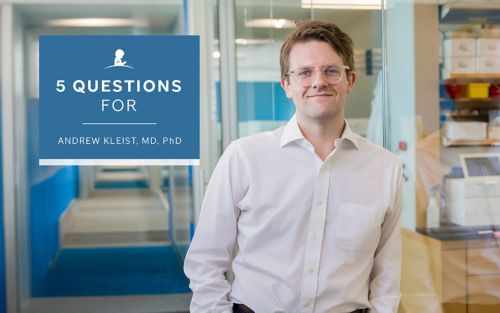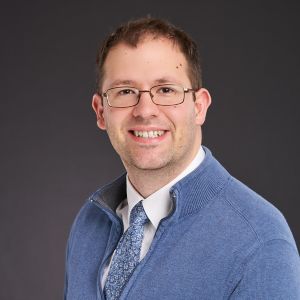St. Jude Family of Websites
Explore our cutting edge research, world-class patient care, career opportunities and more.
St. Jude Children's Research Hospital Home

- Fundraising
St. Jude Family of Websites
Explore our cutting edge research, world-class patient care, career opportunities and more.
St. Jude Children's Research Hospital Home

- Fundraising
5 Questions for Andrew Kleist, MD, PhD

This question-and-answer series explores the motivations, inspirations and accomplishments of investigators at St. Jude. Andrew Kleist, MD, PhD, is a lead computational research scientist in the Department of Structural Biology. He works in the laboratory of M. Madan Babu, PhD, FRS, St. Jude Senior Vice President of Data Science, Chief Data Scientist, Center of Excellence for Data-Driven Discovery director, and Department of Structural Biology member. Kleist was recently named a 2025 STAT Wunderkind, honoring the contributions of early-career biomedical researchers.
1. What motivates you as a scientist?
Science often entails exploring a new terrain with no map, or sometimes with a very old map that is incomplete. I get most excited about science when I feel like there is an opportunity to make a very useful new map, one that brings different types of information into the same place. A very good map allows you to understand where you are currently, but also where you came from and where you are going, and does so in an intuitive, visually accessible, easy-to-use way. It should be detailed enough to be useful but not so detailed as to be uninterpretable. I am motivated most by the process of making these maps, which can be thought of as scientific frameworks for conceptualizing different types of information that were previously difficult to understand.
2. What questions are you trying to understand with your research?
At a high level, the questions I’m most interested in seeking to understand are how events that happen on the molecular scale lead to changes at the organismal scale. In most of the projects I am working on, the molecular scale events involve trying to understand the behavior of proteins by examining their three-dimensional structures. How do two proteins fit together? If one gets a mutation, does that change how it interacts with others? How do drugs alter a protein’s structure or movements? Proteins are like miniature Rube-Goldberg machines, so I try to piece together their domino-brick-like mechanisms to see how they change under different circumstances. On a more specific level, I am working on multiple collaborative projects related to how mutations in influenza proteins impact their pathogenicity, how aberrant signaling through cell surface receptors can lead to cancer progression and how genetic-level variants affect protein structures and lead to human disease.
3. How did your mentors shape your scientific career?
My first scientific mentor was a postdoc in the laboratory I was working in during college. I had a very limited understanding of what research was or how it worked. I had read the professor’s webpage and thought I had a general idea what the group was studying, but at a basic level I didn’t understand much of anything. My postdoc mentor cut through the technical jargon. He made it clear what the point of our research was, but more importantly, he convinced me that what we were working on was exciting and essential. When I got a result, even insignificant, he reminded me that I was the only person on Earth to know the result of the experiment. He also gave me agency – he let me develop my own small project that at the end of the day I could say was my own work. This was instrumental in getting me hooked, and I went on to make a small contribution to his paper and was included as a coauthor. I hung the paper on my wall for years. I’ve had many amazing mentors since then, and all have modeled different virtues introduced to me by my mentor in college:
- Science is complicated, but it is also very exciting, so you should “invite” others across the threshold so they can enjoy it too.
- Science is most exciting when you get a ‘turn at the wheel.’
- Be kind and supportive to colleagues at every level of training and expertise, everyone can make a difference.
4. You recently were recognized as a 2025 STAT Wunderkind early career scientist. What does that mean to you?
It’s a huge honor to be recognized for this award. I’m amazed to read the biographies and accomplishments of past winners; it’s hard to believe that I was recognized for the same award. I’m very grateful to all the people who have made my success possible, my wife and daughter, my parents, my mother in-law, my many colleagues and friends from graduate school and my mentors, past and present. Among my mentors, I’m particularly indebted to Dr. Babu here at St. Jude, and Brian Volkman, PhD, Medical College of Wisconsin, who helped shape me as a scientist. Being recognized for this award is a testament to all of their mentorship and support.
5. What advice would you give others seeking to excel in their scientific careers?
One lesson I might impart could be summarized as: “it’s not about what it’s about.” The annals of science are full of people who start studying unusual organisms or topics and in doing so go on to discover fundamental aspects of our world. Studying finches can teach you about finches, but it can also teach you about natural selection, which is what Charles Darwin documented to establish the theory of evolution that applies to all organisms. For individuals looking to be successful in science, I would recommend considering the possibility that their chosen topic of study similarly has the opportunity to reveal deep, fundamental insights into our world, if only viewed from the right vantage point.







